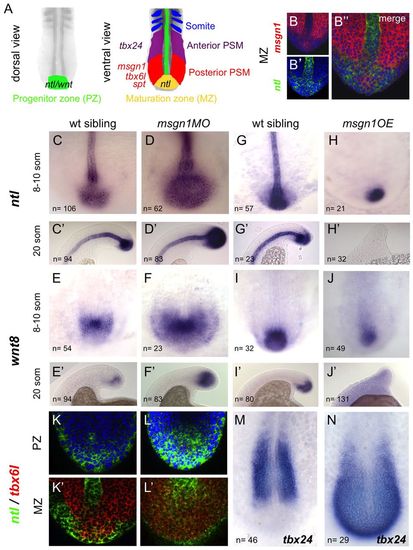
Msgn1 regulates the transition from the maturation zone to the PSM. (A) Diagram of sequential gene expression as a mesodermal cell progresses from a progenitor state in the dorsal superficial tailbud until incorporation into a somite. (B-B′′) Double fluorescent in situ hybridisation for msgn1 (red) and ntl (green) in a wt zebrafish embryo. (C-J′) Expression of ntl (C-H2) and wnt8 (E-J2) in msgn1MO-injected embryos (D,D′,F,F′) and their siblings (C,C′,E,E′) and in embryos overexpressing msgn1 (H,H′,J,J′) and their siblings (G,G′,I,I′). At the 8- to 10-somite stage (H), 55% of msgn1-overexpressing embryos showed an absence of notochord ntl staining and 33% presented notochord breaks, but some expression of ntl was still evident in the tailbud. At the 20-somite stage (H′), 88% of these embryos showed an absence of ntl staining in the tailbud; this 88% consisted of 66% that showed no notochordal ntl expression and 22% that showed some notochord staining. In both H and H′, 12% of the injected embryos appeared wt. Seventy per cent of msgn1OE embryos showed continuing but strongly downregulated wnt8 staining at the 8- to 10-somite stage (J); the remaining 30% exhibited a total absence of wnt8 expression. By the 20-somite stage (J′), expression of wnt8 had disappeared completely. (K-L′) Confocal images of double fluorescent in situ hybridisation showing expression of ntl (green) and tbx6l (red) in a msgn1MO-injected embryo (L,L′) and an uninjected sibling (K,K′) at the 8- to 10-somite stage, in the superficial dorsal progenitor region (K,L) and at the level of the notochord, where ntl and tbx6l expression overlap (K′,L′). (M,N) Expression of tbx24 in a msgn1 mRNA-injected embryo (N) and its sibling control (M) at the 8- to 10-somite stage.
|

